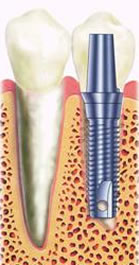PerioNZ.org
Sponsored by the New Zealand Society of PeriodontologyTreatment Options
Surgical Treatments
Pocket Elimination & Periodontal Flap Surgery
In certain circumstances, scaling and root planing alone may not be sufficient to deal with the periodontal disease, especially in patients who present with more severe periodontitis. Such patients will normally require further treatment in the form of periodontal surgery. Modern surgical treatments are generally minimally invasive and generally well tolerated by patients. There are a variety of surgical techniques used in the management of severe periodontitis each having their specific indications. Periodontal flap surgery allows the clinician to better access and remove bacteria and calculus deposits that on the tooth root surfaces deep beneath the gum tissues. Pocket elimination surgery aims to promote better adaptation of the gum tissues around the teeth and also helps patients to better maintain their oral hygiene through home care.
Learn more about Periodontal Flap Surgery
http://www.perio.org/consumer/procedures.htm
Guided Tissue Regeneration (GTR) Surgery
In some cases the damaged caused to the gum attachment and supporting bone of the teeth caused by periodontal diseases can be repaired using Guided Tissue Regeneration. This highly specialised treatment technique involves cleaning carefully around the tooth root to remove all plaque bacteria and calculus deposits by gently teasing back the edge of the gum from around the neck of the tooth when the gum is numb with dental anesthetic. The damaged gum and bone around the tooth root is then treated with thin membrane (filter) or growth factor. The gum is then carefully adapted back around the teeth and secured with some very small stitches. This surgical technique allows the gum attachment fibers and bone around the tooth to regenerate giving the tooth a better prognosis.
For further information on GTR
http://www.perio.org/consumer/procedures.htm
Non Surgical Treatment
Scaling & Root Planing
Scaling refers to the professional removal of soft plaque and hard calculus (tartar) deposits from the teeth and around the gum line. This is a non-surgical treatment. It is undertaken using hand instruments (scalers or curettes) and/or sonic/ultrasonic instruments which use high frequency vibrations to help remove these deposits from the tooth surface.
Root planing is an extension of scaling which involves getting down further under the gum line to remove plaque and calculus from the tooth root surface. This is usually undertaken while the gum tissues are numb with dental anesthetic so that the treatment can be performed painlessly. Scaling and root planing aim to provide a clean smooth tooth and root surface in order that the gum tissue/ attachment has a chance to heal around the tooth. Both scaling and root planing are non-surgical treatments. Scaling and root planing may sometimes be combined with antibiotic treatment to assist in the management of the gum infection.
Performing Proper Oral Hygiene
Being able to clean your teeth properly is not necessarily as easy as it sounds. Being able to removal plaque from certain areas in you mouth can be challenging. Professional advice and the right tools for the job can go a long way to ensuring that the time you do spend cleaning your teeth and gums is time well spent. Here are some preliminary suggestions to get you started.
Tooth brushing-twice daily.
Brushing removes the sticky film of bacteria from the teeth and from around the gum line. A soft-bristled toothbrush that is in good condition is recommended. Electric toothbrushes can also be of tremendous benefit for many patients providing they are used appropriately. The use of toothpastes containing fluoride helps to strengthen the teeth and prevent decay. Certain toothpastes can also help reduce tooth sensitivity.
Cleaning between teeth daily.
Dental floss or interdental brushes can be used to remove bacteria and food particles from between the teeth where a toothbrush can't reach. The early signs of gum disease (gingivitis) may be reversed by careful daily brushing and flossing. The use of interdental brushes requires instruction by a trained dental professional to prevent injury to the gum tissues and to ensure effective plaque removal.
Regular Dental Visits
Visiting your dentist or hygienist and having professional cleaning is important in the prevention of both tooth decay and periodontal diseases.
Learn more about non-surgical treatments
http://www.perio.org/consumer/procedures.htm
Asthetic Treatments
Improve your smile or Aesthetic Periodontics or Let your gums reflect a more beautiful you
There is no doubt that one's appearance can lead to a more self assured and confident you. The first impression you make is always important and you could improve that impression by being satisfied with your smile. A large proportion of our population is not completely satisfied with their smile. Sometimes this is due to the shape, position and colour of the teeth, but more frequently the shape and contour of the gum tissue, and indeed just how much gum tissue shows when smiling, is seen as an important part of that first impression.
Here are some of the problems with the gum shape and contour that people are often concerned about:
- Uneven gum line
- Gummy smile
- Gum recession or appearing ‘long in the tooth'
- Shaping of the gum line when combined with aesthetic dentistry
Uneven gum line
Are you contemplating having a smile makeover? Are you going to have those teeth restored with new crowns or porcelain veneers? It is essential for the long-term success of your new smile to make sure the gums are completely healthy before you start. This may just mean making sure your gums are free from disease and starting an excellent home care programme. Or it may mean that you could consider having the gum line sculpted before you start so that the best possible result can be achieved. It is also possible that you have lost a tooth in the past and that the contour of the jaw where the tooth was lost appears as a ‘hollow’ defect. This defect can be improved by ridge augmentation procedures, which will help your dentist achieve the best aesthetic results for you. If any of the above situations make you think ‘That’s me!’ then ask your dentist to recommend a periodontist who can discuss your needs and help design the smile that you are looking for.
Gummy smile
Does your smile present a picture of teeth that are too short or of more pink than white? This may mean that you have too much gum tissue showing due to an alteration in the way your teeth erupted. Crown lengthening procedures may be the most suitable way to shape the gum line and to make the teeth appear a more normal size and shape. Sometimes however this problem is more complex than it first appears and discussion with your dentist or periodontist may help you decide the best approach to dealing with the situation.
Gum recession
Gum recession means that some of the gum tissue that used to be around your teeth has been lost. This can lead to your teeth appearing longer than they should and give the impression of being ‘long in the tooth'. Exposure of more tooth than is usual can lead to concerns about appearance, sensitivity of the tooth surface that has become exposed, or increased likelihood of tooth decay on the exposed root surface.
Gun grafting procedures are plastic surgical procedures to help provide improved aesthetics for you smile. They also help to stop the sensitivity mentioned above, and can also help prevent the root surface decaying.
Gum contouring for aesthetic dental procedures
Are you contemplating having a smile makeover? Are you going to have those teeth restored with new crowns or porcelain veneers? It is essential for the long-term success of your new smile to make sure the gums are completely healthy before you start. This may just mean making sure your gums are free from disease and starting an excellent home care programme. Or it may mean that you could consider having the gum line sculpted before you start so that the best possible result can be achieved.
It is also possible that you have lost a tooth in the past and that the contour of the jaw where the tooth was lost appears as a ‘hollow' defect. This defect can be improved by ridge augmentation procedures, which will help your dentist achieve the best aesthetic results for you.
If any of the above situations make you think ‘That's me!' then ask your dentist to recommend a periodontist who can discuss your needs and help design the smile that you are looking for.
Dental Implants
What is a Dental Implant?
A dental implant is a tooth-root analogue (replica). It is an artificial tooth root made of surgical grade titanium, which is placed into the jaw bone onto which crowns and bridgework can be constructed. Dental implants can in many cases be the preferred treatment to replace a tooth or teeth lost following an injury or through periodontal disease.
On the far right a natural tooth with root held in the jaw bone. Next to the tooth is a titanium dental implant with a porcelain crown on it. The diagram highlights the similarities between the natural tooth and a single tooth dental implant.
What can dental implants do?
Dental implants can be helpful to replace one or more teeth as follows:
Replacing a Single Tooth
If you are missing a single tooth, a single dental implant with a crown can be used to provide a very natural and durable tooth replacement.
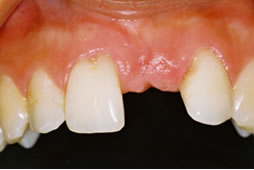
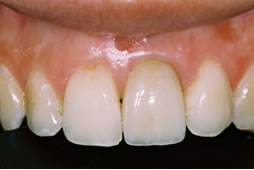
Before After
Replacing Several Teeth
If you are missing several teeth, they can be replaced individually with dental implants or implant-supported bridges.
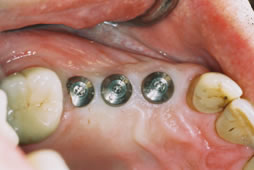
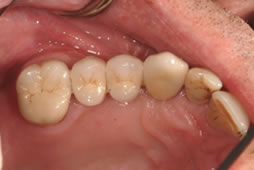
Before After
Replacing All of Your Teeth
If you are missing all of your teeth, it is possible to use implant to support a fixed bridge and thus doing away with a removable denture. In some cases it may be more appropriate to place dental implants to help support and retain a removable denture (implant supported overdenture).
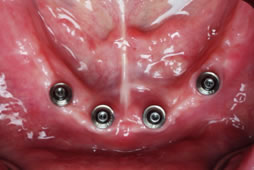
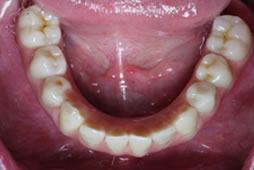
Before: Lower Jaw with 4 implants After: Lower Jaw with fixed implant bridge
Are you a candidate for Dental Implants?
Generally, you need to be in good general health as well as having a healthy mouth. Dental implants require adequate jaw bone to allow placement and for good retention. It is important that, if you are considering dental implant treatment, there is no active periodontal (gum) infection present in you mouth as this can have a negative effect on your dental implant treatment. It is also important to discuss with your dentist all the different treatment options for tooth replacement (denture, bridge, dental implant) with your dentist to determine if dental implant treatment is the most appropriate one for you.
Who should I see to have my Dental Implant Treatment?
Dental Implant treatment is typically a team effort. In most cases it is your general dentist who will undertake the initial assessment of your mouth to see if tooth replacement with dental implants is the most suitable treatment option for you. In New Zealand Dental Implant surgery is usually performed by periodontists, oral surgeons and some general dental practitioners. However, as dental implants are intimately connected with the gum tissues and underlying bone in the mouth, Periodontists are the ideal members of your dental implant team to be surgically placing your implants. Not only do periodontists have experience working close with other dental professionals, they also have the special knowledge, training and clinical skills to deal with the complexities that are often encountered during dental implant surgery. Once dental implants have been placed and healed with the jaw most patients return to their dentist to have the final crowns, bridge or dentures fabricated and attached to the dental implants.
Learn more about Periodontal treatment
http://www.perio.org/consumer/procedures.htm

